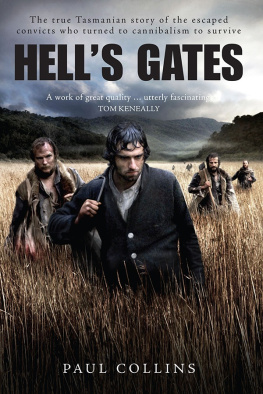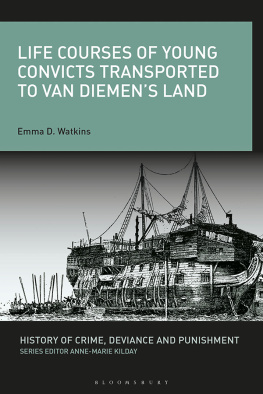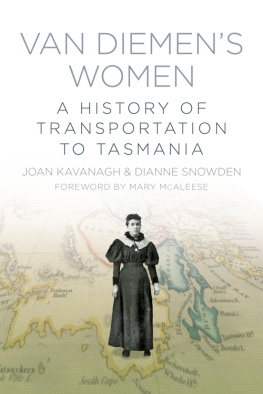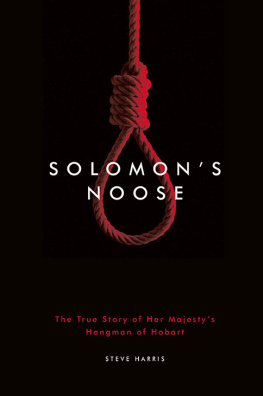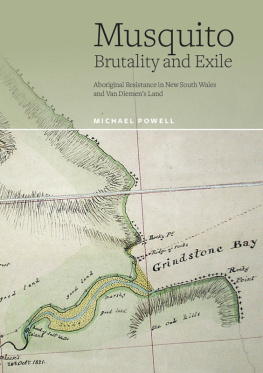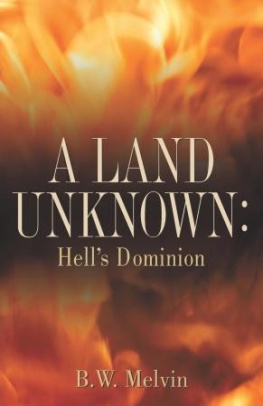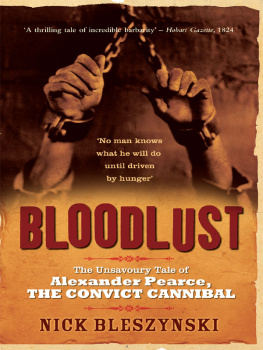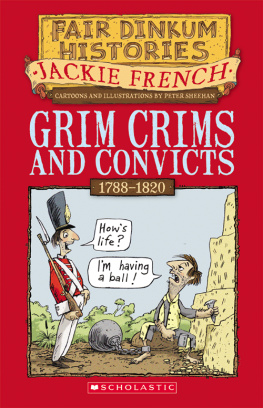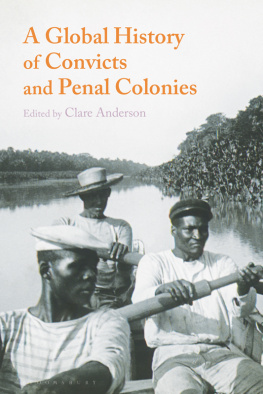HELLS GATES
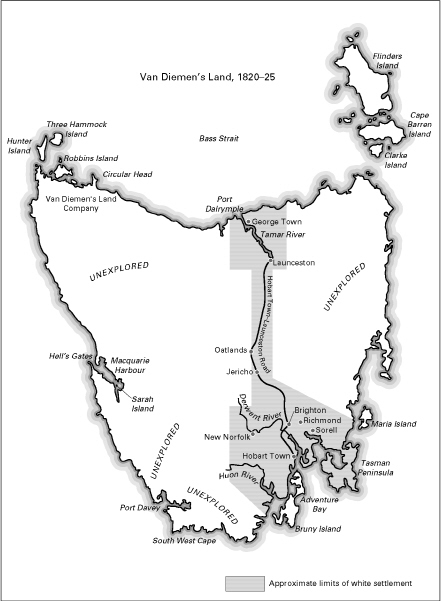
HELLS GATES
THE ESCAPE OF
TASMANIAS CONVICT CANNIBAL
PAUL COLLINS

This edition published in 2004
First published in 2002 by
Hardie Grant Books
12 Claremont Street
South Yarra, Victoria 3141, Australia
www.hardiegrant.com.au
All rights reserved. No part of this publication may be reproduced, stored in a retrieval system or transmitted in any form by any means, electronic, mechanical, photocopying, recording or otherwise, without the prior written permission of the publishers and copyright holders.
The moral right of the author has been asserted.
Copyright text Paul Collins 2002, 2004
National Library of Australia Cataloguing-in-Publication Data:
Collins, Paul, 1940 .
Hells gates: the escape of Tasmanias convict cannibal.
ISBN 1 74066 148 6.
1. Pearce, Alexander, ca.17901824. 2. Convicts Tasmania
Biography. 3. Penal colonies Tasmania. 4. Cannibalism Tasmania.
5. Trials (Murder) Tasmania. I. Title.
365.6092
Cover design by Jo Hunt
Text design by Guy Mirabella
Cover image (top) by Thomas Bock, Alexander Pearce executed for murder, 1824,
crayon on paper. Courtesy Dixson Library, State Library of New South Wales;
(bottom) by Hayman & Piguenit, Frenchmans Cap, 1886 wood engraving.
Courtesy Tasmaniana Library, State Library of Tasmania.
Maps by Guy Holt
Typeset by J & M Typesetting
Printed and bound in Australia by Griffin Press
10 9 8 7 6 5 4 3 2 1
CONTENTS
Anyone who writes history is constantly in the debt of others. This is especially true when Alexander Pearce and his exploits have become the subject of numerous inaccurate books, newspaper and magazine articles, extending over a period of more than 150 years. Within fifty years of his execution, Pearce had metamorphosed into the appalling Gabbett, the convict cannibal of Marcus Clarkes For the Term of His Natural Life (London, 1875). Nowadays many Australians have heard of Pearce and know some of the details of the story, but they are often confused between fiction and fact. In sorting it all out I have been helped enormously by a number of people. I want to record here the names of just a few who guided me in the task of trying to get the story right.
Everyone who writes about Pearce is in the debt of Dan Sprod. He was the first researcher to sort out fact from fiction in what we know about Alexander Pearce. His Alexander Pearce ofMacquarie Harbour: Convict Bushranger Cannibal (Hobart, 1977) is thorough, meticulous and reliable. Without his groundwork and careful research my task would have been close to impossible. As well as Dan Sprod, there are a number of other writers whose work has been very helpful and I have tried to acknowledge each of them in the bibliographical essay.
For the Sarah Island penal settlement and for convict remains generally in the Macquarie Harbour area, I am deeply in the debt of Richard Davies. Richards knowledge and understanding of the history and archaeology of the area is unrivalled, and a tour with him will teach you more in a day than you can learn in weeks of research. He is also extraordinarily generous in sharing all that he knows. He is the writer and usually one of the actors in the comedy-drama The Ship That Never Was, which is performed year-round in the theatre next to the Visitor Information Centre in Strahan. I am particularly grateful to Richard and his family for the warm welcome I have always received from them.
Over the years since 1970, when I first went to Tasmania as a resident, I have seen the town of Strahan change from an isolated and quiet fishing village known only to a few Tasmanians and to an even smaller number from the mainland, to something of a national and even international tourist mecca. Not everyone approves of this, but the people of Strahan are always courteous and helpful to visitors. When you have visited the place as often as I have for over thirty years you can speak of local kindness with confidence.
Bushwalkers and those who work for the Tasmanian Parks and Wildlife Service love the bush, and they love talking about it even more. I interviewed several of them to tap into their experience and knowledge of western Tasmania and the World Heritage Area. Terry Reid, Senior Ranger in Queenstown for the Parks and Wildlife Service, is west-coast born and bred, and he shared his knowledge of the Tasmanian west vast and detailed as it is with me generously. Geoff Law, campaigner for the Wilderness Society in Hobart, has an immense and intimate knowledge of the Tasmanian bush; he literally seems to have been everywhere on the island. Like Terry, Geoff can speak from personal experience of what it is like to try to penetrate the country traversed by Pearce and the other escapees. Both men also have a thorough understanding of the possible routes taken by the Pearce group.
Two others who helped me enormously in understanding the lay of the land, the vegetation, fire regimen and the route options were Sue Rundle and Dr Jon Marsden-Smedley of the Parks and Wildlife Service in Hobart. Both have an intimate knowledge of the bush. Another who helped me understand the topography and possible routes was Dr Simon Kleinig of Adelaide, a very experienced bushwalker himself, who is at present working on a history of the Frenchmans Cap region. I am deeply indebted to their generosity.
Well-funded public institutions are essential to any working democracy, and especially helpful to independent scholars like myself. The libraries and archives that I have used over the years have constantly had to struggle to make ends meet, and have had to live with the never-ending cuts imposed on them. These institutions still survive on the skill, knowledge and generosity of their staff and the richness of their holdings. Especially helpful in writing this book were the librarians and archivists of the National Library of Australia, and the library system of the Australian National University, both in Canberra; the Tasmaniana Library, the Allport Library and the Archives Office of Tasmania, all in Hobart; the Mitchell Library in Sydney; the National Archives of Ireland in Dublin; and the City of London Archives. The microfilms of the Australian Joint Copying Project were also very helpful; they have made an extraordinary amount of British and Irish archival material available to Australian researchers. Other sources are mentioned in the bibliographical essay.
There are four specific people I must mention. Mary Cunnane is my literary agent and I am deeply indebted to her skill, support and sensible advice. Caroline Williamson and Foong Ling Kong have been real professionals who are dreams to work with, as have been the staff of Hardie Grant.
And finally, my dear friend Marilyn Hatton has listened to endless versions of this book, made pivotal critical comments and accompanied me on several trips to Tasmania, during which we experienced something of the south-west and the country through which Pearce and his cohorts travelled. I deeply appreciate her love and support.
Canberra, August 2002
HELLS GATES
Somewhere to the west of the confluence of the Ouse and Shannon rivers,Van Diemens Land, early November 1822.
It was early morning. Although the air was still cold, when you moved out of the shadows you could feel the suns heat. The sky was completely cloudless and the sheer clarity of the light illuminated every aspect of the landscape. A tree-covered hill sloped toward a grassy area that bordered a small, reed-filled swamp opening out onto a shallow lake. The source of the lake was a creek that flowed from the higher ground to the north and another creek emptied out of the marsh and lake toward the south. A thin mist hovered above the lakes surface. A group of about twelve light brown, mallard-sized ducks with a black strip across their eyes was grazing beside the swamp. Despite their colouring, they are known in Australia, where they are very common, as Pacific Black ducks. A number of this group were juveniles, but they had already taken on the plumage and colouring of their parents.
Next page
